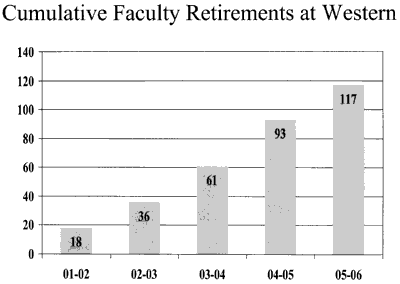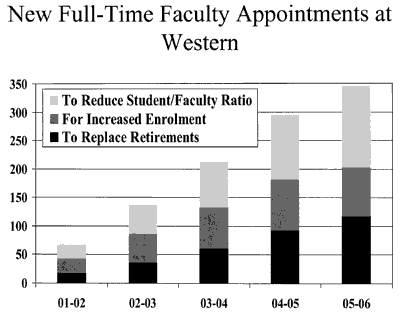IV. Faculty
Western's faculty both full-time and part-time, can take great pride in their accomplishments over the last decade. In the face of a student-faculty ratio that increased by 25% over the last ten years, our faculty members have introduced new academic programs, while maintaining very high teaching standards and expanding research substantially. Using a measure for which smaller is better, the student-faculty ratio in Ontario is now some 11.5% above that in the other Canadian provinces and 35% above that in U.S. public universities. The quality of our teaching and research under these conditions has been truly remarkable.
Our academic community regards part-time faculty as critically important to achieving our goals in both teaching and research. In the classroom, laboratory, and clinical setting, these faculty are both committed and effective. We take great pride in their accomplishment and their role in fulfilling the University's educational mission.
To improve the quality of education our students receive and to encourage smaller classes, Provincial funding in Ontario should aim to bring our student-faculty ratio to the average of the other nine provinces over the next five years. The most recent year for which student-faculty data are available for all ten provinces is 1998-99. The ratio of full-time equivalent students to full-time faculty was 21.3:1 in Ontario and 19.1:1 in the other nine provinces, a difference of 11.5%. We view an 11.5% reduction in the present student-faculty ratio as a reasonable goal for Ontario by 2006 and believe that Provincial funding should be adjusted accordingly. During the next five years, accommodating enrolment expansion and reducing the student-faculty ratio by 11.5% would result in an increase in faculty complement of some 229, from 1,014 in 2000-2001 to 1,243 in 2005-2006. At that point, the student-faculty ratio would be about 18.0:1, approximately its value in 1995-96, but still well above its value in the 1980s and early 1990s.
Related Charts
 |
 |
With an allocation of $220 million to universities for increased enrolment in the May 9, 2001 budget, the Province made a significant first step in stopping the increase in Ontario's student-faculty ratio, by giving full average public funding for additional students at 2000-2001 rates for the next three years. To stabilize the student-faculty ratio, universities require additional funding to meet reasonable inflationary cost increases. Without such adjustments to grants, part of the funds for new enrolment will go to cost increases, and the student-faculty ratio will continue to rise, as shown in the graphs on page 9 and 13 with lines labeled “No inflation provision.” With full funding for growth and reasonable cost increases, Western would require an additional $17 million (11.5% of our Provincial operating grant) to reduce the student-faculty and student-staff ratios by 11.5%, as shown in the graphs on page 9 and 13 with lines labeled “Goal.” If we think of the $220 million in the May 9 budget as an Accessibility Fund, an additional Quality Fund is now required to bring down the student-faculty ratio in Ontario to the average of the other nine provinces.
In this environment of constrained resources, we face a severe challenge in faculty recruitment over the next decade, with four distinct elements: the increase in faculty retirements; the increase in enrolment from the echo of the baby boom; graduate programs which have not expanded to meet the future demand for faculty; and the double cohort produced by the restructuring of Ontario's secondary school system, with students who entered grade nine in 1998 or 1999, all graduating in 2003. Because the first three elements are North-American wide, we expect severe competition for faculty from universities throughout Canada and the United States.
Western expects nearly 120 faculty retirements over the next five years. To replace those faculty members, carry out the enrolment expansion approved by Senate and the Board and reduce the student-faculty ratio by 11.5%, would require the hiring of nearly 350 faculty. This represents both a difficult challenge and a great opportunity.
To strengthen the University in this competitive environment, we will need to maintain our high standards for recruitment at all levels: we cannot allow the constrained academic labor market to reduce our expectations of new faculty or to temper the rigors of our appointment, promotion and tenure processes. It is vital that the important role of Faculty budgets in providing start-up funding be understood, particularly in the laboratory sciences. Western needs to do a better job in recruiting female faculty members and retaining them at senior levels; our proportion of female faculty at the senior ranks is presently below the average of other Canadian research universities. Although statistical data on other equity-targeted groups is problematic due to small sample size, Western is also committed to increasing its representation of First Nations, visible minorities and persons with disabilities. In the current environment, excellence requires that Western be an attractive destination for the full diversity of young faculty, including those from all the groups identified under the Employment Equity Act and the Federal Contractors Program, to which the University is a signatory. Moreover, a growing part of our recruitment involves potential faculty with a spouse working outside the home; we need to review our spousal placement and assistance practices if we are to be competitive. In this environment, passive searches for new faculty are not enough; Western must recruit aggressively and effectively to attract the most distinguished teachers and researchers to our University.
Related Charts
 |
 |
In this difficult labor market, the best new faculty will be seeking a university where they can build a distinguished career in teaching and research. They will be attracted to areas of current and potential strength, where the University is seen to be making significant investments. Our new hiring will need to be selective, based on clearly defined Departmental, School, Faculty, and University priorities. This Task Force report places a high priority not only upon disciplinary and professional, but also upon interdisciplinary and inter-Faculty teaching and research, priorities which should be carefully weighed in all decisions concerning faculty appointments, promotion and tenure.
Once new faculty members arrive at Western, we should direct specific attention toward mentorship. Some Departments have developed innovative programs in this regard and others should be encouraged to follow their example. It is also of crucial importance to retain our most productive and distinguished mid-career and senior faculty members. The continuing development and reward of established faculty is critical to retention. Our collective agreement allows flexibility in academic responsibilities, and we should use that flexibility to ensure the best match between personal skills and University needs.
Our Commitments:
2. Western will recruit outstanding faculty over the next decade, scholars who will enhance our distinguished reputation in teaching and research, and will work to retain our distinguished established faculty members.
Our University community will:
2.1 Encourage appointment committees to use aggressive strategies to recruit the very best teachers and researchers to Western's faculty;
2.2 Maintain high standards for recruitment, promotion, and granting of tenure for faculty;
2.3 Provide competitive salaries and start-up funding;
2.4 Continue our efforts to hire and retain more female faculty and to promote more female faculty members to positions of Department, School, Faculty, and University leadership;
2.5 Strengthen our efforts in spousal/partner placement and assistance;
2.6 Ensure that our hiring is supportive of applicants from diverse backgrounds, including the designated groups identified under the Employment Equity Act and Federal Contractors Program;
2.7 Ensure that new appointments are made in areas of priority and strength, as set out in the Academic Plans of the Departments, Schools, Faculties, and the University;
2.8 Seek in new recruitment and retention decisions to support interdisciplinary and inter- Faculty teaching and research, acknowledging that academic disciplines evolve and that it is the nature of some scholarship to cross traditional disciplinary lines;
2.9 Expand the mentoring of new faculty by experienced faculty;
2.10 Enhance means of retaining outstanding faculty through such means as the establishment of University Distinguished Professorships, provision of research support in areas less likely to attract targeted government funding, and creating opportunities for public recognition and celebration of their achievements;
2.11 Work through our collective agreement to provide development opportunities for faculty in both the areas of teaching and research and, in conjunction with the Faculty Association, to harmonize and coordinate the instruments through which faculty report their activities;
2.12 Continue to urge alumni, community leaders, and provincial officials to support a new investment of public funds in Ontario's universities which would allow a reduction in the student-faculty ratio of 11.5% by 2006, to reach the current ratio in the other nine provinces.
